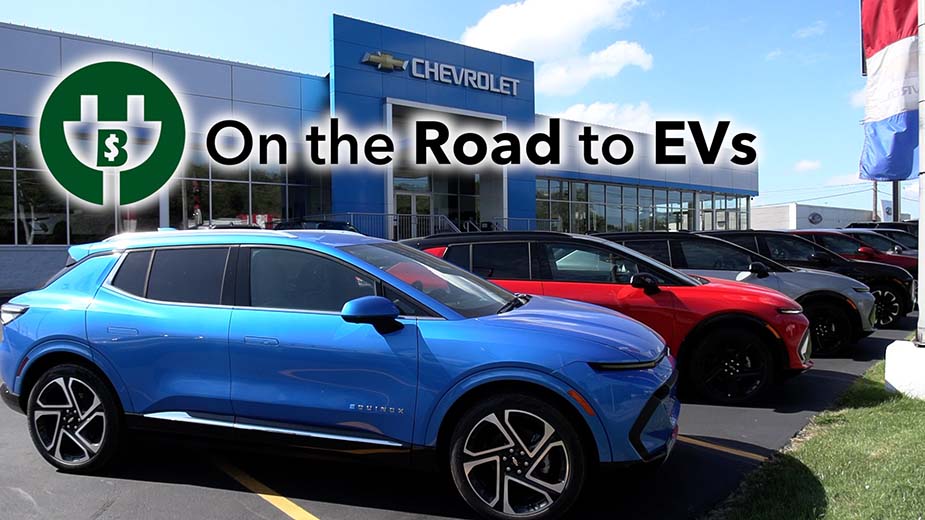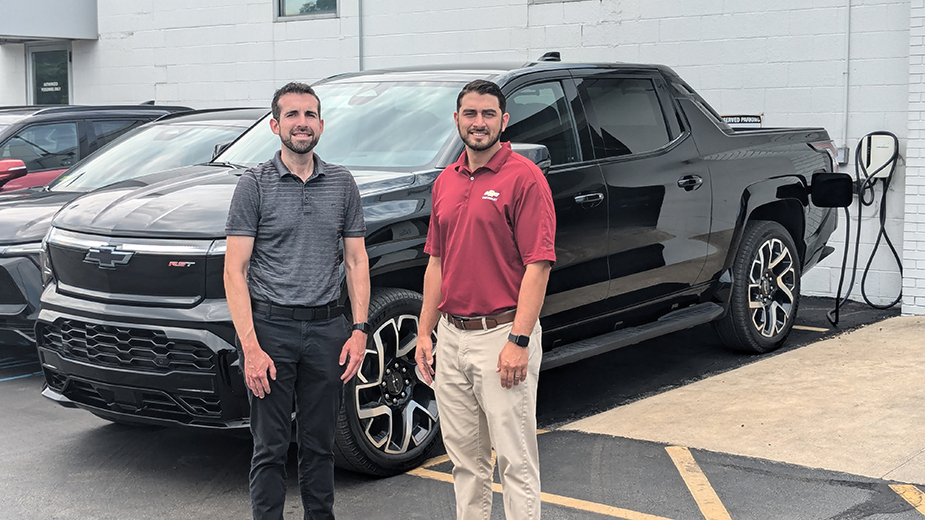Buick Looks Back, Forward to EV Future
Third in a Series
YOUNGSTOWN, Ohio – The name Buick Electra harkens to an era when passenger cars sported delta fins, shiny chrome grilles, hard bubble tops and thick front fenders.
At the same time, the name heralds a sleek new future for the venerable brand, as General Motors Co. mounts one of the most ambitious transformations in its history to stake a claim in the emerging electric-vehicle market.
“All we really know is that Buick will be a full-EV lineup in North America and the first one will be out in 2024,” says Alexa Sweeney Blackann, president of Sweeney Chevrolet Buick GMC in Boardman. “All of them will carry the Electra name.”
The Buick Electra served as the top sedan of the brand from its introduction in 1959 to its discontinuation in 1990. Electra Waggoner Biggs, an accomplished sculptor and the sister-in-law of then-GM president Harlow Curtice, inspired the name of the vehicle.
By late next year, the Electra will be reborn as the very symbol of GM’s aggressive strategy to reframe the 119-year old Buick brand as a pioneer in EV technology. Although few details of the GM plan have been released, longtime Buick dealers such as Sweeney are excited about its future.
“We hope to see the first one on the lot by the end of the 2023 calendar year,” Blackann says. “We’ll be excited to share more details when we have them.”
Buick intends to convert its entire vehicle portfolio to an EV platform by 2030, GM has said. Currently, the nameplate offers four SUVs that are all powered by internal combustion engines.
The first of Buick’s EVs will be an SUV built on Ultium Cells LLC’s scalable battery platform, GM has said. The vehicle’s precise features and architecture remains a mystery. In June, however, Buick unveiled a concept vehicle whose design is likely to guide the future look of the brand.
“What’s really exciting is the Wildcat,” Blackann says.
Last month, Buick released renderings of its new concept vehicle, the Wildcat EV Concept. The car is designed as a coupe with striking, modern features such as a wrap around windshield, semi-swing doors, and the use of advanced artificial intelligence and biometric technology.
“The cabin adapts to its user to make suggestions and a variety of functions,” Therese Pinazzo, Buick exterior and interior design manager, says of the EV concept in a promotional video.
Bob Boniface, director of Buick global design who was born and reared in the Mahoning Valley, says in the video that the Wildcat “leaves an unmistakable impression with its timeless proportion and low, ultra-wide stance. The front fascia shows the new face of Buick, which is dramatic and impossible to ignore.”
Mounted in the center of the concept vehicle is a refreshed Buick badge, which keeps the three red, white and blue shields – slightly redesigned – without the silver ring encircling them.
Although the Wildcat EV Concept is shown as a coupe, the objective is to establish a base framework from which to build future Buick EVs under the Electra name – all of which as of now will be SUVs, GM officials say.
Buick’s timing for its transition is perfect, says Jessica Caldwell, executive director of insights at Edmunds. “If they’re ever going to reset themselves, now is the time,” she says. “They’ve tried for a long time to reinvent this brand and now is the best chance they’ve had in decades to do so in the United States. It’s kind of their moment.”
More important, Buick’s transformation is likely to draw more first-time customers to the brand into showrooms – particularly younger buyers who once would’ve dismissed the nameplate as more fitting for their parents or grandparents.
“It’s going to be a new crowd,” Caldwell says. “It’s not just the Buick customers that will be drawn to Electra.”
Caldwell says that already the brand has made important strides to reverse earlier perceptions – especially through its luxury appeal and technology. Adopting a full EV strategy is going to only enhance this image and engender an entirely new generation of buyers.
“It’s prepared them to put Buick on the best footing they’ve had in a long time,” Caldwell says. “The Wildcat is such a departure. It’s super sleek and where they’ll be taking a lot of their designs from.”
While Caldwell says GM is taking a risk with its aggressive EV strategy for Buick, it’s a risk that the automaker must take. “What else is there for the future of Buick?” she asks rhetorically.

Sweeney’s Blackann says it’s exciting to trace the evolution of Buick. The Sweeney dealership, formed in 1921, became a Buick franchise in 1931 and operated under the name Buick Youngstown for years.
Even the Wildcat EV is a term that is steeped in Buick tradition, Blackann says. “Both the Electra and Wildcat are throwbacks from Buick’s history,” she says.
The first Wildcat concept was introduced in 1953, followed by others in 1954 and 1955. It was produced as a full-size passenger car between 1963 and 1970 and was used again in 1985 as a concept for a mid-engine, all-wheel drive sports car.
Today, Buick is renowned as a brand that exemplifies the latest in vehicle technology plus a steady legacy, says Derek Snyder, executive manager and partner of Sweeney Buick GMC.
“I own a ’63 Riviera and a 2022 Envision,” he says. “I think it’s come a long way and the brand has been able to adapt. That’s why we’ve been here for the last 100 years.”
Throughout its history, Snyder says, Buick remained faithful in producing a “vehicle for the people,” a brand that has appealed to muscle car enthusiasts, family transportation and to those who prefer weekend cruisers.
“Then, they started to make the change to more tech-savvy vehicles,” Snyder says. In 2012, for example, Buick made the leap to bundle its tech package with a two-year lease that included connectivity with OnStar road assistance, XM Radio and maintenance. Other tech features followed, such as intelligent all-wheel drive and safety measures like front pedestrian braking, lane change alert, side blind zone alert, rear cross traffic alert, and forward collision alert.
Among the other amenities are in-vehicle air ionizers and massaging, heated and ventilated front seats. Also, the brand included in its SUV lineup reliable connectivity with a built-in Wi-Fi hotspot.
All of these features were geared in part to building a new audience for Buick, Snyder says. “When Buick rebuilt their lineup, they had a younger buyer in mind.”
Buick was the first manufacturer to partner with Amazon.com to have built-in Alexa voice-activated control, Snyder says. “You can order a pizza from your car, change the temperature of your vehicle, play music, get directions, place calls, control your smart home and more – all with your voice,” he says.
Through myBuick Skill for Alexa, a driver can instruct the device to start the vehicle, check tire pressure or other diagnostics via any Alexa device.
“These technology offerings are building blocks to the EV future with Buick,” Snyder says.
The demographics of the average Buick customer have also changed over the years, Snyder says. “Buick resonates with the female buyer,” he says. “It has the highest percentage of female buyers in the United States at 56.1%.”
Women lead Buick’s interior and exterior design teams, Snyder says, and the brand’s marketing campaign over the last several years has focused on female consumers. “We’ve recognized early that female buyers are the most important in our market,” he says.
Meanwhile, Buick continues to sell well in the United States and globally, Snyder says. “Last year was Buick’s best sales year ever for its current lineup.” Retail sales in the United States were up 7.6% compared to the previous year, he says.
More important is that 73% of those buyers were new to Buick, reinforcing the broad appeal of the brand today, Snyder says. “That just shows you the momentum of this brand right now.”
Buyers today simply don’t identify Buick as a name synonymous with “older” consumers any longer, Snyder says. “Younger buyers aren’t aware of the old stigma. They see a fresh lineup of SUVs. It’s hard to associate today’s Buick with the Buick sedans of 20 to 30 years ago.”
The name instead is more closely associated with reliability, safety, luxury, high-tech and dependability, Snyder says.
Buick, for example, was named the overall No. 1 brand in the J.D. Power 2022 U.S. Initial Quality Study. Indeed, a national commercial recognizing the distinction was recently shot in Sweeney’s Buick GMC showroom.
All of these factors place Buick in position to capture market share as it pivots to an all-electric inventory over the next eight years, Snyder says.
“Buick intends to be a leader in the EV space,” he says, noting its entry-level products should carry a price of approximately $30,000.
“There’s a mindset out there that you can’t afford an EV,” Snyder says. “Buick changes that. I call it ‘attainable luxury’ and the opportunities are endless.”
Pictured at top: Alexa Sweeney Blackann says she is excited about Buick’s all-EV future.
Editor’s Note: On the Road to EVs is sponsored by Sweeney Chevrolet Buick GMC. Click here for more coverage of Sweeney and General Motors transitioning to electric vehicles.
Copyright 2024 The Business Journal, Youngstown, Ohio.



